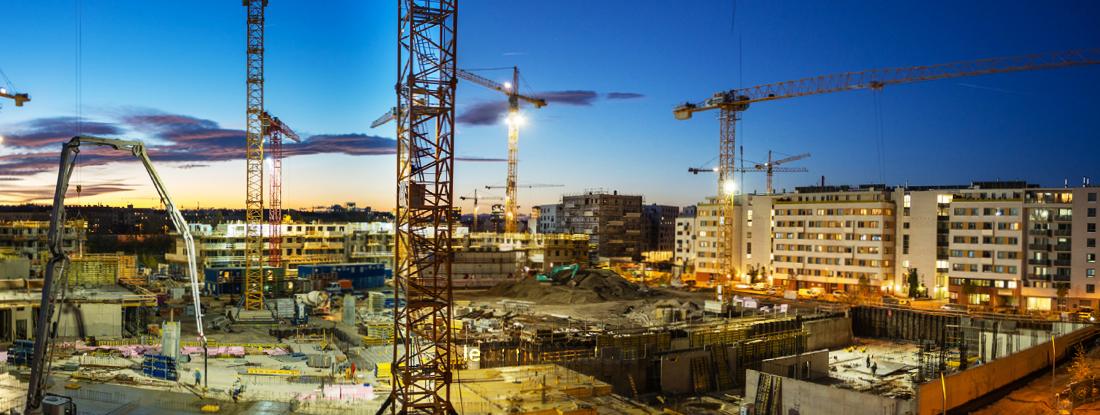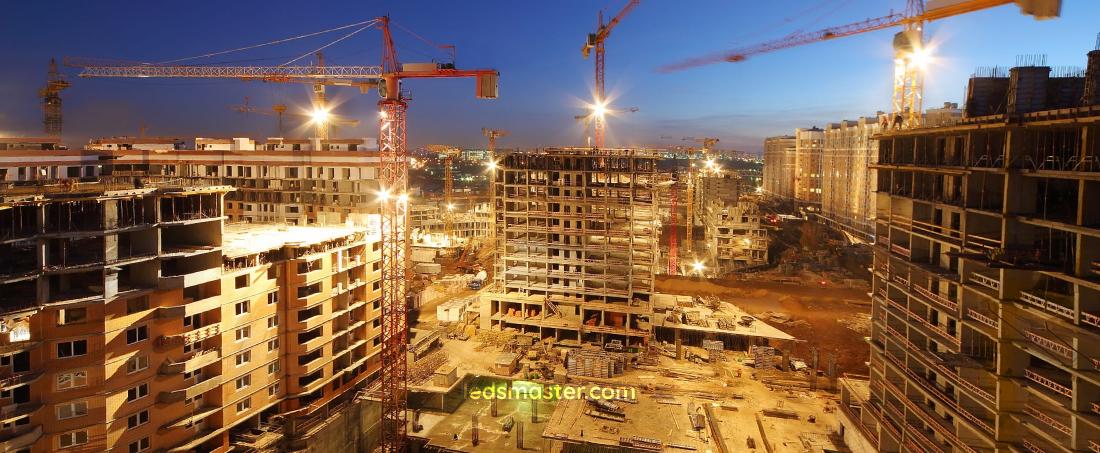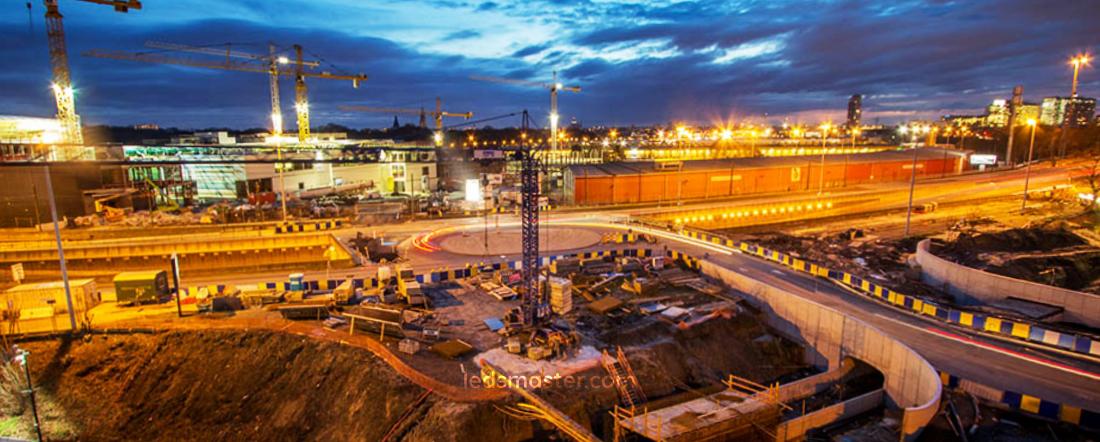From illuminating expansive areas to supporting precise tasks, well-planned lighting enhances productivity and adapts to the evolving needs of construction projects, keeping workers safe and operations seamless.
Get your complimentary lighting design today
Construction lighting design refers to the strategic planning and implementation of lighting solutions to illuminate construction sites effectively. Proper lighting enhances the visibility of tasks, ensuring that work progresses smoothly, even during nighttime or low-light conditions. Depending on the stage and scope of a construction project, lighting requirements may vary from temporary setups for work in progress to permanent installations for architectural purposes.
Table of Contents
ToggleWork environments at construction sites often feature uneven surfaces, heavy machinery, and hazardous areas. Proper illumination helps workers identify obstacles, avoid potential hazards, and complete tasks with precision. By reducing shadows and minimizing glare, lighting systems contribute to a safer workspace where the risk of accidents is significantly lowered.
Construction projects frequently operate under tight schedules that necessitate around-the-clock work. Adequate lighting ensures that workers can maintain focus and efficiency, regardless of the time of day. It supports the performance of detailed tasks such as welding, inspections, and measurements, which require high visibility for accuracy.
Construction lighting design must align with established standards and regulations, including those set by the Occupational Safety and Health Administration (OSHA) and local authorities. Compliance ensures that lighting systems meet the required levels of illumination, creating a safe and legally approved working environment.
Lighting solutions for construction sites are designed to optimize energy consumption without compromising visibility. Modern technologies, such as LED lights and renewable energy-powered systems, help reduce energy costs while supporting environmental sustainability.

Each construction project has unique lighting needs based on its scale, complexity, and stage of development. Large-scale projects like highways or industrial plants may require high-mast lighting systems, while smaller, localized tasks benefit from portable floodlights or task lighting. Additionally, the phases of construction, such as excavation, structural building, or finishing, influence the choice of lighting equipment.
Lighting systems should adhere to regulations that specify minimum illumination levels for various tasks. For example, OSHA mandates different lux levels for general site lighting, specific task areas, and emergency pathways. Ensuring compliance with these guidelines fosters a safe and well-lit environment.
Construction sites utilize various lighting types, including fixed and portable options. Fixed lighting is often used for consistent illumination of large areas, while portable solutions provide flexibility for dynamic site conditions. Temporary lighting setups are frequently employed during construction phases, whereas permanent lighting focuses on the finished structure’s aesthetic and functional needs.
Weather conditions and site-specific challenges influence lighting design. Outdoor sites require weatherproof fixtures that can withstand rain, dust, and extreme temperatures. Managing glare and shadows is also vital to ensure clear visibility and reduce strain on workers’ eyes.
Incorporating motion sensors into construction lighting systems provides energy efficiency and enhanced functionality. These sensors activate lights only when movement is detected, conserving power during periods of inactivity. They also improve security by illuminating areas where unauthorized access occurs.
Certain high-risk or hazardous construction environments benefit from using bulletproof lighting fixtures. These durable designs offer resistance to impacts, ensuring that lighting equipment remains operational even in challenging conditions. Such features enhance both safety and the longevity of the lighting systems.

Area lighting focuses on illuminating large zones to provide general visibility. High-mast towers and floodlights are commonly used for this purpose. These fixtures are mounted on poles or towers to cast light over extensive spaces, making them ideal for open construction sites such as roadways and bridges.
Task lighting is designed for specific activities that require concentrated light. Spotlights and portable LED lamps are examples of equipment used for precision tasks like welding, cutting, or equipment inspections. These lights ensure workers can perform detailed operations without errors.
Backup systems are crucial for maintaining safety during power outages or equipment failures. Battery-operated and generator-backed lights provide consistent illumination to enable uninterrupted work and safe evacuation if needed. Emergency lighting also helps highlight escape routes and hazardous zones.
Hazard lights are used to mark dangerous areas or restricted zones on construction sites. These lights, often red or yellow, serve as visual warnings to prevent workers or machinery from entering risky locations.
| Lighting Type | Purpose | Examples |
|---|---|---|
| Area Lighting | General illumination for large zones | Floodlights, high-mast towers |
| Task Lighting | Focused light for specific activities | Spotlights, LED lamps |
| Emergency Lighting | Backup illumination during outages | Battery-operated fixtures |
| Hazard Lighting | Warning for restricted or dangerous areas | Warning lights, barricade markers |
The initial step in construction lighting design involves evaluating the site to identify its specific lighting requirements. This includes analyzing the size, layout, and types of activities conducted on-site. Planners must consider the location of obstacles, shadows, and high-traffic areas to optimize lighting placement.
A comprehensive lighting plan outlines the positioning, type, and number of fixtures required to achieve the desired illumination levels. By strategically placing lights, the plan ensures even coverage while minimizing blind spots or over-lit areas.
Choosing the right lighting fixtures depends on factors such as durability, energy efficiency, and adaptability to site conditions. For example, LED lights are preferred for their longevity and low energy consumption, while weatherproof designs are necessary for outdoor applications.
Before implementation, lighting setups are often simulated using design software to visualize the distribution of light across the site. Testing these configurations under actual conditions helps identify potential issues and make adjustments to enhance performance.
Proper installation ensures that lighting systems function as intended. Regular inspections and maintenance schedules help identify and address issues such as damaged fixtures or reduced light output, maintaining consistent illumination throughout the construction process.

Different construction tasks require varying levels of illumination to ensure accuracy and safety. General site lighting, for example, needs lower lux levels compared to precision tasks like welding or inspections. The following table outlines typical lux requirements for various construction activities:
| Area/Task | Recommended Lux Level | Description |
|---|---|---|
| General site illumination | 50–100 | Ensures basic visibility for movement and equipment operation. |
| Pathways and stairwells | 100–150 | Provides safe navigation for workers and prevents accidents. |
| Task areas (e.g., assembly work) | 200–300 | Supports moderate-detail activities requiring better visibility. |
| Precision tasks (e.g., welding) | 500+ | Necessary for detailed work where accuracy is critical. |
International and local standards, such as those by OSHA or the European Lighting Standards (EN 12464-2), provide specific guidelines for lux levels in construction environments. Adherence to these standards ensures compliance with safety regulations and prevents workplace hazards related to poor visibility.
One of the significant challenges is achieving an effective balance between cost considerations and the durability or functionality of lighting solutions. High-quality lighting equipment often comes with a higher upfront investment, but it can result in long-term savings through reduced energy usage and maintenance costs. Projects with tight budgets may face difficulties in prioritizing long-lasting solutions.
Construction sites are ever-changing environments. As work progresses, the layout of the site evolves, and previously well-lit areas may become obscured by new structures or equipment. Lighting systems must be flexible and mobile to adapt to these shifting conditions, which can complicate planning and implementation.
Excessive or poorly directed lighting can contribute to light pollution, affecting nearby residential areas and wildlife habitats. Striking a balance between adequate site illumination and minimizing environmental disturbances is a challenge, particularly in urban or ecologically sensitive areas.
Overly bright lighting or fixtures that produce excessive glare can cause discomfort and even safety risks for workers. Proper lighting design must account for factors such as glare reduction, color temperature, and uniformity to create a comfortable working environment that minimizes eye strain and distractions.
Outdoor construction sites are exposed to varying weather conditions, including rain, wind, snow, and extreme temperatures. Lighting equipment must be weatherproof and durable enough to withstand these conditions without compromising performance. Sites in regions prone to severe weather may require additional measures to protect lighting systems from damage.
Effective construction lighting design is an integral component of modern construction projects, ensuring safety, enhancing productivity, and facilitating the efficient execution of tasks. By addressing project-specific needs and adhering to established lux requirements, lighting systems can create a well-illuminated environment that supports both worker well-being and operational precision. Incorporating advanced features like motion sensors and durable fixtures, while adapting to dynamic site conditions, further enhances the adaptability and efficiency of lighting solutions. As construction evolves, integrating sustainable technologies such as LED lights and renewable energy sources can reduce environmental impacts and operational costs.